Think about it. . . How many times have you had a frustrating experience with a website? Confusing layouts. Unreadable buttons. Forms that make you question your existence. That’s not user error. That design has gone rogue.
And the biggest culprit? A lack of usability testing.
In this guide, we’re going deep into the what, why, and how of UX testing. Not in a boring, robotic way. But in a way that makes you actually want to test your product before users rage-quit.
Whether you're a startup founder, a CIO, or a business owner who just wants customers to use the damn thing, this one’s for you. If you’re looking for professional support, you can hire a usability tester to ensure your product gets real-world validation before launch.
Is Your Product Usable in the Long-Term?
User experience testing answers exactly this question Your website's usability testing process involves an actual user trying to navigate through it. Like standing behind a one-way mirror while someone tries to use your product.
You’re watching where they struggle and where they are comfortable. It highlights which parts of the interface or flow are making the overall experience uncomfortable. This real-time feedback is crucial for analysis and improvement.
Think of it as quality control for the human experience, the foundation of user-centered design. Learn how usability fits into the bigger picture with our guide on usability testing in the UX design process.
Usability Testing vs. Traditional Testing: A Comparative Overview
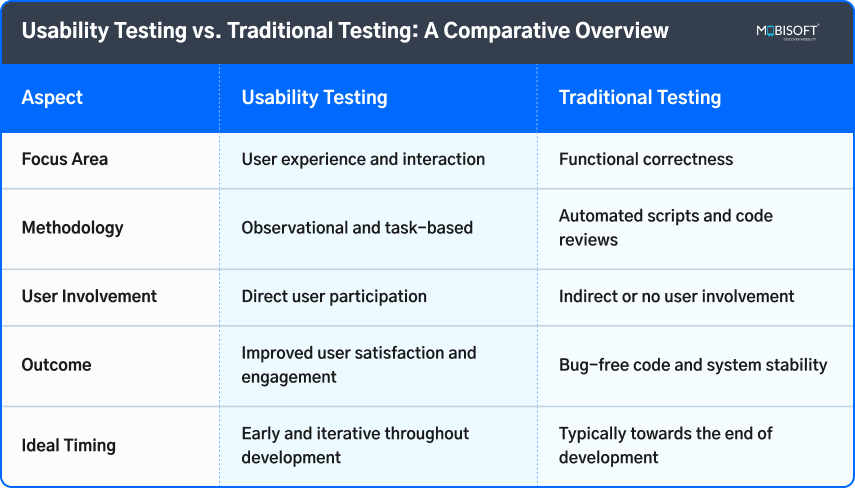
Want to strengthen your design team? You can hire expert UI/UX designers to create user-friendly digital products.
Why Are Usability Testing Services Important?
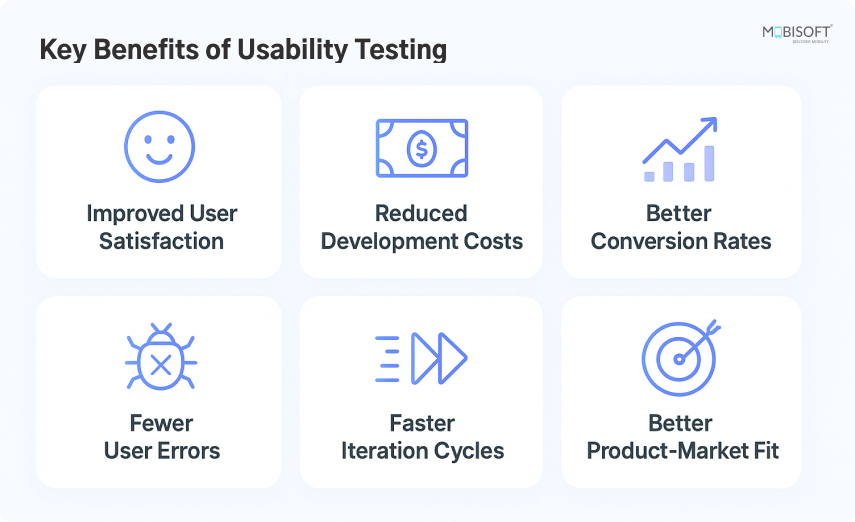
Yes, because you're not designing for yourself. It’s for the users. So you need to think like one. They skip instructions. They ignore the flashing red buttons. They press “back” the moment they get confused.
Recent studies show that 80% of users will delete an app if it has two technical issues. Usability testing services help you catch these issues before your product hits the market. Or worse, gets roasted on social media.
It’s cheaper than rebuilding. It’s faster than guessing. And it’s way more effective than staring at your screen hoping your design “just works.”
Source: Why Testing is Critical for UX in 2025
When Should You Conduct Usability Testing?
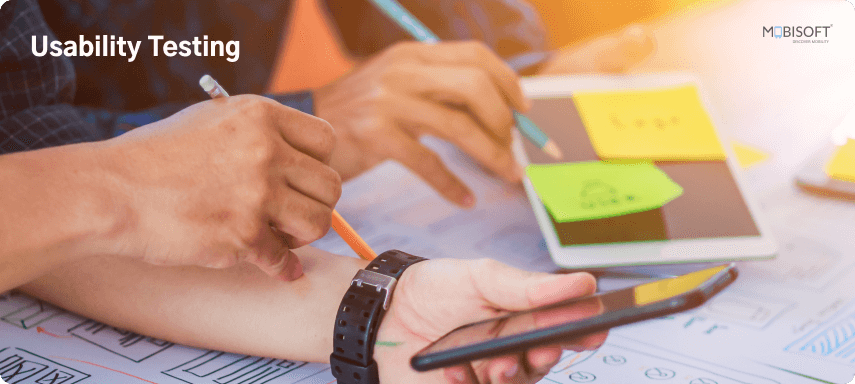
Short answer: early and often.
Long answer: run usability tests at every major milestone. Before you start building. Midway through development. After launch. And every time you roll out something new.
Usability testing is the last crucial check you need to make before making your product live. Sure, the product might be great. But there are always minor touchpoints, which will eventually become a problem for the users.
A good design foundation matters. Check out our web UI/UX design services to ensure your digital products are intuitive from the start.

The Different Flavors of Usability Testing Methods
There’s no one “right” way to do usability testing. Here are the most common usability testing examples:
Moderated Testing
A member of the team supervises while the user engages with the app. You can note observations, ask for feedback, conduct a Q&A, etc. The objective is to find out prevailing issues, although the methods are varied.
Example: Watching a user try to edit their profile while they mutter, “Wait, where is the settings icon?”
Unmoderated Testing
The user tests on their own time. You send them a link, they record the session, and you get back unfiltered reactions. No pressure. No judgment. Just the truth.
Remote Testing
Perfect for distributed teams or users in different cities. Tools like Maze, Lookback, and Useberry let you record sessions without ever booking a meeting room.
In-Person Testing
Old-school but still effective. Great for physical products or when you want to see every micro-expression as users wrestle with your design.
For more insights, don’t miss our blog on common mobile UX mistakes and how to avoid them during testing.
Running the Usability Testing Process: Step by Step
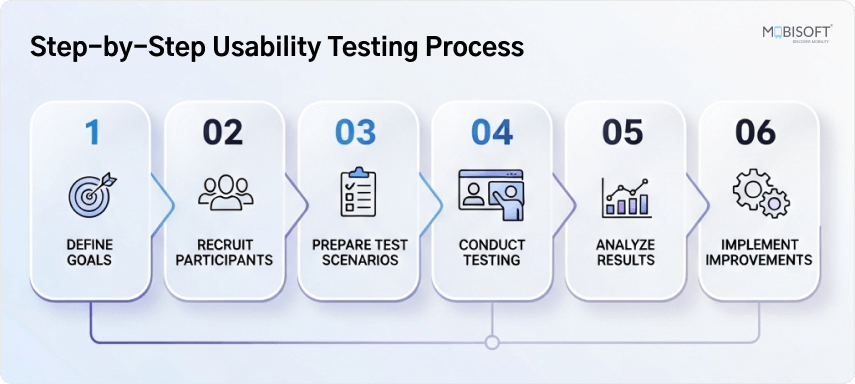
Now let’s walk through the whole process, from setting goals to acting on results. Follow these practical steps that work.
Step 1: Set Your Goals
What exactly are you trying to learn? Be specific.
Don’t just say “I want to test the homepage.” Say something like:
- Can users find the main CTA in under 10 seconds?
- Do users understand the pricing structure?
- Where do users drop off during sign-up?
Clear goals lead to focused UX testing. Focused tests lead to useful insights. It’s that simple.
Step 2: Recruit the Right Users
Don’t let your colleagues or co-workers be the testers. Bias can skew your results. Select people across different age groups (but from your target audience), with a mix of skill levels. Your group should represent a small version of your target audience.
You want real users. People who might actually use your product. Ideally, a mix of skill levels. First-timers. Regular users. The curious. The impatient.
And no, you don’t need a huge sample size. Research shows that 5 to 7 users can uncover most major usability issues.
Quality > Quantity. Always.
Step 3: Choose Realistic Tasks
Now’s not the time for fantasy scenarios. You want real, common, everyday tasks that your users would naturally try to complete.
For example:
- “Find and apply a discount code.”
- “Schedule an appointment with a therapist.”
- “Add a second user to your account.”
Never provide a blueprint to follow; let the test users navigate freely. This helps with realistic feedback. Make sure the tasks are complete with a defined objective. This step also helps in customer experience testing.
Step 4: Create a Script (And Stick to It)
Don’t spend too much time writing the perfect script. All it needs to be is clear and concise.
Structure it like this:
- Start with a warm-up: basic questions like “Have you used similar products before?”
- Explain the rules: “There are no right or wrong answers.”
- Introduce tasks one at a time.
- End with follow-up questions: “What confused you most?” “What felt easy?”
Remember to finalise a script and use it for every single participant. Varying instructions will lead to varied results.
Step 5: Observe, Don’t Interfere
The golden rule of usability testing best practices: Observe, note, and analyse.
Don’t guide them. Don’t explain the design. Let them fumble. Let them complain. That’s where the magic happens.
Ask questions like:
- “What are you trying to do here?”
- “What do you expect to happen next?”
- “Was that what you thought would happen?”
But never lead them. If someone gets stuck, don’t say “Click the top-right button.” Just take notes. That top-right button needs fixing.
Step 6: Record Everything
Video. Audio. Screen recordings. Facial reactions, if possible.
Trust your future self. You will forget things. And small details matter.
You’ll want to look back and catch subtle moments. The pause before a click. The frown. The sigh. The “Huh?” was whispered under their breath. Those little things point to big problems and support behavioral usability testing.
Step 7: Analyze the Results
Now, time to play detective.
Look for patterns. Where did people hesitate? What did everyone miss? Which tasks led to frustration?
You don’t need to overcomplicate this. Create a list of:
- Major issues (things that block users from completing tasks)
- Minor annoyances (things that confuse or slow them down)
- Suggestions (things users wished existed)
The goal isn’t to fix everything, just fix the biggest pain points. This stage supports interaction design testing and user interface evaluation.
Step 8: Share What You Found (Without Making It Boring)
Don’t just email a PDF. No one’s going to read it.
The findings should be precise, but interesting. Try laying it out in story format. The flow can be: what we tested, how we tested, what we found, and what we propose.
Include:
- Short video clips or quotes
- Screenshots of issues
- A clear list of next steps
Make it visual. Make it human. Make it actionable.
Step 9: Iterate and Retest
- Usability testing isn’t a one-time event.
- Test. Fix. Test. Repeat.
- Every time you add a new feature, change a flow, or redesign a page, test it.
Beyond testing, great design also depends on trust. Learn more about designing for trust in UX.
Stages of Usability Testing in App Development
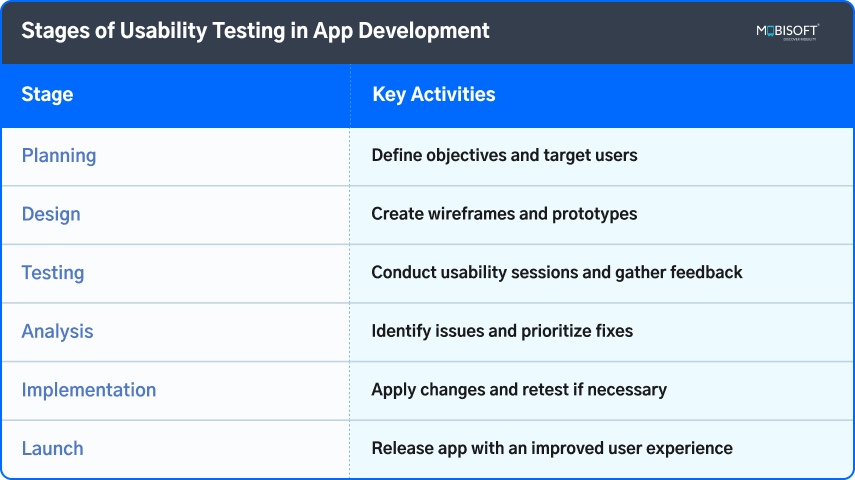
Because usability isn’t static. Your product evolves. So should your feedback.
Avoid These Pitfalls in UX Testing
According to GoodFirm’s 2025 Startup Mobile App UX Design Survey, 91.2% of respondents reported that ux testing is "extremely important" before launching a startup app, while 88.3% gave 5-star importance ratings to having strong UX. Let’s round it out with some don’ts:
Source: 2025 Startup Mobile App UX Design Survey
Don’t test too late
Waiting until code exists raises costs and limits options. Test initial drawings, wireframes, and prototypes. Testing early enables design flaws to be found with repairs remaining cheap and quick. Late changes force development rework and deprioritization. Schedule usability checks at milestones to prevent expensive rewrites and stakeholder friction, and launch delays across teams.
Don’t ask leading questions
Leading questions steer users to answers you want. Use open prompts that invite behaviour, not opinions. Ask what they expect to happen, what confused them, or where they looked first. Neutral phrasing uncovers authentic reactions. Train moderators to listen, probe objectively, and record observed behaviour rather than seeking validation instead. This aligns with solid user research methods.
Don’t rely on opinions
Personal preferences do not equal usability. Use observed behaviour and task completion as your primary signal. Integrate qualitative observations with numerical measures such as time on task and success rates. Write comments as hypotheses, never as orders. Focus on solutions that enhance quantifiable results and verify again to establish that you've helped the user. This is part of human-computer interaction (HCI) testing.
Don’t ignore results
Collecting data and filing it away wastes time and budget. Turn findings into specific, prioritized actions. Link each problem to a prospective solution, owner, and date. Provide results to stakeholders with concise evidence and concise video clips whenever feasible. Follow up with impact after-fix to show value and inform roadmap decisions.
Don’t recruit the wrong participants
Testing irrelevant users produces misleading results. Define target personas and recruit participants who match core customer segments. Screen for experience level, goals, and context of use. Small is fine if representative. Document recruitment criteria, so findings translate to product decisions. Better matches yield clearer signals and avoid costly misdirection entirely.
Strong design and testing go hand in hand. Explore our mobile app UX design services to deliver seamless user experiences.
Common Usability Issues and Their Solutions
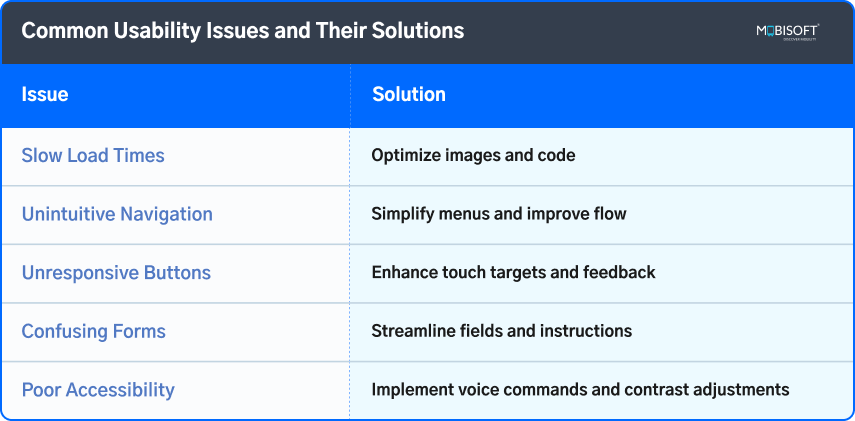
Testing Tools That Will Help
You don’t have to perform the test completely by yourself. Here is a list of usability testing platforms and usability testing software that will help you record and track the process:
- Maze: Great for unmoderated tests and user flows.
- Lookback: Ideal for recording remote sessions.
- UserTesting: Fast access to a pool of testers.
- Hotjar: Not quite testing, but excellent for heatmaps and behavior tracking.
- UsabilityHub: Quick preference tests and five-second tests.
All platforms will serve your purpose well if the procedure is followed correctly. So just pick one that fits both your budget and the product.
The Key to a Seamless UX
Without the right product, even the best marketing strategy won’t be able to convince the users. Usability testing services help the product reach the closest to what they would like. It’s how you build confidence in your product and delight in your users, benefiting both.
The only important thing about conducting usability testing is “Can real people use this the way I intended?” If your testing doesn’t result in a firm yes, you have room for improvement.
Because a great UX experience is crafted with rigorous usability testing best practices and improvements. These iterations are what differentiate a random UX from a memorable one.
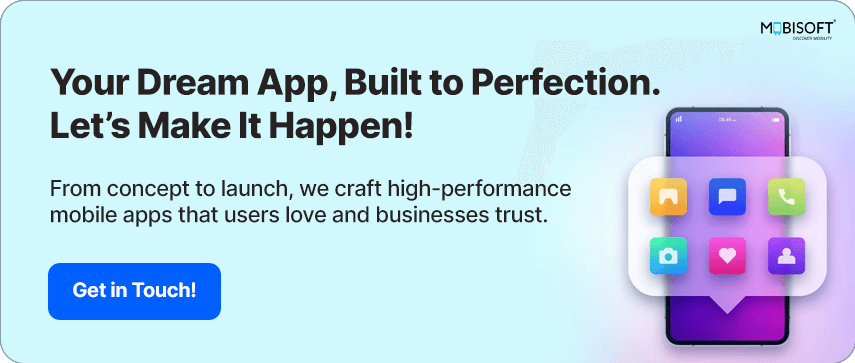
Key Takeaways:
- Usability testing prevents failure: Most frustrating user experiences come from untested designs, making usability testing the safeguard against product rejection.
- It’s about real users, not you: Testing reveals how actual users behave, often skipping instructions or misinterpreting flows. Untested assumptions stop users from adopting your product.
- Test early and often: Running usability tests at every stage, from prototypes to post-launch, saves money, time, and reputation.
- Different methods fit different needs: Moderated, unmoderated, remote, and in-person testing each offer unique advantages depending on context and resources.
- Follow a clear process: Setting goals, recruiting representative users, creating realistic tasks, observing without interference, recording, analyzing, and iterating ensures reliable insights.
- Avoid common mistakes: Late testing, leading questions, opinion reliance, ignoring results, and wrong participant recruitment all compromise outcomes.
- Tools simplify execution: Platforms like Maze, Lookback, and Hotjar help streamline testing, making it accessible without heavy infrastructure.
- Usability drives business outcomes: Great UX builds confidence, reduces churn, and turns a product from “just usable” into “memorable.”

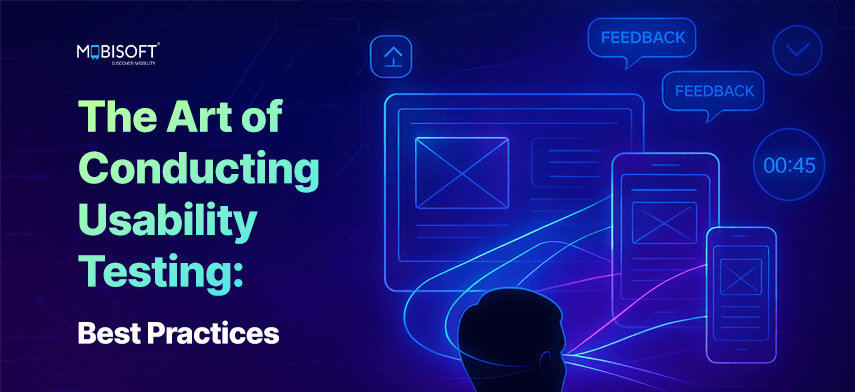


 September 11, 2025
September 11, 2025


